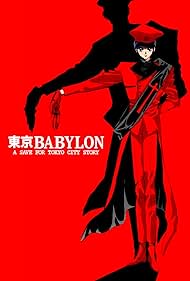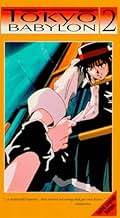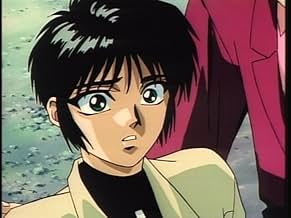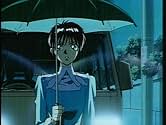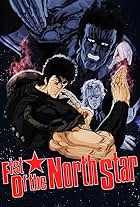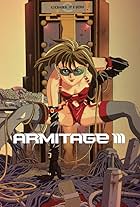IMDb RATING
6.5/10
343
YOUR RATING
Subaru Sumeragi, a young Onmyouji sorcerer, investigates a series of unusual murders with the aid of his twin sister and fellow Onmyouji Seishirô.Subaru Sumeragi, a young Onmyouji sorcerer, investigates a series of unusual murders with the aid of his twin sister and fellow Onmyouji Seishirô.Subaru Sumeragi, a young Onmyouji sorcerer, investigates a series of unusual murders with the aid of his twin sister and fellow Onmyouji Seishirô.
Browse episodes
Storyline
Did you know
- TriviaThe three main characters are named after the Japanese names for astronomical constellations:
- Subaru is the Japanese name for the Pleiades
- Hokuto is the Japanese name for the Big Dipper
- Seishirou is the Japanese name for Orion.
- ConnectionsFeatured in Clamp (2003)
- SoundtracksKiss Kiss
Performed by Hideaki Matsuoka
Featured review
This is a little-known gem from CLAMP (the superstar all-woman manga team) and (at the time) young director Kôichi Chigira. Chigira would later go on to work as an animator on the 'X Movie' (to which 'Tokyo Babylon' is a sort of prologue) and to direct 'Full Metal Panic!' and 'Last Exile.' CLAMP, after finishing the 'Tokyo Babylon' manga (on which the show is based) in 1993, immediately started their greatest work: 'X.' So this show, which is actually two separate 45 minute episodes (made in 1992 and 1994), comes at an important time in CLAMP history: just before they hit it big. As a result, what we have is an enjoyable but unfortunately limited OVA (Original Video Animation, known here as Direct-to-Video) that acts as an interesting side story to anyone who has read the 'Tokyo Babylon' manga or seen the X television series or film (as there are some shared characters).
The first episode, unceremoniously called 'Tokyo Babylon 1' on the DVD, takes several elements of the manga and adapts them to a new story. Several 'accidental' deaths at a high-profile construction site have drawn the attention of the local authorities. Perplexed, they turn to Subaru Sumeragi, a young practitioner of the Onmyouji arts (an ancient type of Japanese sorcery with roots in the tantric magic of China and India). Subaru uses his powers in a way similar to other anime characters to solve the mystery, but what is interesting here are the unmistakable chants and unusual references. One who is not familiar with the Onmyouji might think this is all made up, but it has roots in Japanese history. Onmyouji were imperial court officials who determined official policy. In a modern context, they link the dark and dreary modern Tokyo depicted with a richer and somehow more 'true' past filled with mysterious powers. Though this can pass by the casual viewer, for those interested in mythology, it is intriguing.
Subaru works with his twin sister, Hokuto and a family friend, veterinarian Seishirou. Although seemingly lacking in Subaru's powers, as the story goes on, some new (and for Seishirou, perhaps darker) facets of the supporting characters are revealed. Hokuto meanwhile has the 'fun' idea of trying to get her brother fixed up with the handsome veterinarian, much to Subaru's chagrin. However, this element of the manga is kept to a minimum in the anime, so those averse to homo-erotic relationships need not fear. As he continues to puzzle over the mysterious 'accidents,' Subaru encounters a woman who seems bent on revenge against the head of the construction project, who himself seems to have a secret power. The finale of the episode, while at the time (remember, this is 1992) well-animated for an OVA, looks somewhat dated now. However, if one is forgiving of this and is willing to approach the episode as a product of its time, it is enjoyable.
The second episode ('Tokyo Babylon 2') is also on the DVD and is the real reason for buying the show. Animated two years later with an improved budget, this is one of those shows that is really great, especially late at night with all the lights off. Subaru this time has to investigate a series of midnight subway murders. Nearly the entirety of the film takes place at night, complete with garish lighting and run-down environs that seem more at place in one of 'Patlabor 1's' decrepit neighborhoods. Indeed, there are many parallels between this and the Patlabor film, including an overworked and seemingly sleep-deprived detective who is on the verge of burnout and a mysterious killer who seems more dead than alive in his emotionless actions. Rounding out the cast are two fascinating supporting characters: the 'precognitive' Mirei, who helps the police by sensing the events of past murders using her fingertips, and Miyatake, a young man who collects the fragments of old buildings that are being knocked down. It is eternally fascinating to me that, upon meeting Miyatake out on the street in the middle of the night with a killer loose, Subaru and his group (led by the intrepid Hokuto) happily go up to his apartment to see his collection. Although this is a dark city that seems taxed by its lack of sleep, it is not so dark so as to keep friends from being made. The second episode tells a good story in a short amount of time, second only to the 'Magnetic Rose' segment in 'Memories.' Watching it together with 'Patlabor 1' is also an interesting experience.
All in all, these stories could be better and more accessible than they are, but for what they set out to achieve, they succeed well. I asked Kôichi Chigira at the 2004 Anime Expo about his experience directing these episodes, and he said that it was his decision and not CLAMP's to make the stories shorter and smaller. CLAMP of course approved everything and saved their money to make the spectacular 'X Movie.' In all the many versions of 'X,' both Subaru and Seishirou appear again, this time with a very different relationship. What these episodes are great for is their portrait into the character's lives. For those who've read the manga (and believe me, it is well worth it), the episodes are particularly special as they are two complete 'extra' stories. The English dub should be avoided at all costs, as it was done extremely poorly and Subaru was voiced with a very fake and very obnoxious gay accent (and not at all in a good or respectful way). The Japanese language version has wonderful acting by all, in particular Subaru (who is voiced by the great Kappei Yamaguchi). The reissued DVD version (which comes in a blue case and sells for $10) is a very good deal for the money and has improved subtitling over the previous release. As an enjoyable title, especially for fans of the manga, 'X,' or CLAMP, 'Tokyo Babylon' is highly recommended.
The first episode, unceremoniously called 'Tokyo Babylon 1' on the DVD, takes several elements of the manga and adapts them to a new story. Several 'accidental' deaths at a high-profile construction site have drawn the attention of the local authorities. Perplexed, they turn to Subaru Sumeragi, a young practitioner of the Onmyouji arts (an ancient type of Japanese sorcery with roots in the tantric magic of China and India). Subaru uses his powers in a way similar to other anime characters to solve the mystery, but what is interesting here are the unmistakable chants and unusual references. One who is not familiar with the Onmyouji might think this is all made up, but it has roots in Japanese history. Onmyouji were imperial court officials who determined official policy. In a modern context, they link the dark and dreary modern Tokyo depicted with a richer and somehow more 'true' past filled with mysterious powers. Though this can pass by the casual viewer, for those interested in mythology, it is intriguing.
Subaru works with his twin sister, Hokuto and a family friend, veterinarian Seishirou. Although seemingly lacking in Subaru's powers, as the story goes on, some new (and for Seishirou, perhaps darker) facets of the supporting characters are revealed. Hokuto meanwhile has the 'fun' idea of trying to get her brother fixed up with the handsome veterinarian, much to Subaru's chagrin. However, this element of the manga is kept to a minimum in the anime, so those averse to homo-erotic relationships need not fear. As he continues to puzzle over the mysterious 'accidents,' Subaru encounters a woman who seems bent on revenge against the head of the construction project, who himself seems to have a secret power. The finale of the episode, while at the time (remember, this is 1992) well-animated for an OVA, looks somewhat dated now. However, if one is forgiving of this and is willing to approach the episode as a product of its time, it is enjoyable.
The second episode ('Tokyo Babylon 2') is also on the DVD and is the real reason for buying the show. Animated two years later with an improved budget, this is one of those shows that is really great, especially late at night with all the lights off. Subaru this time has to investigate a series of midnight subway murders. Nearly the entirety of the film takes place at night, complete with garish lighting and run-down environs that seem more at place in one of 'Patlabor 1's' decrepit neighborhoods. Indeed, there are many parallels between this and the Patlabor film, including an overworked and seemingly sleep-deprived detective who is on the verge of burnout and a mysterious killer who seems more dead than alive in his emotionless actions. Rounding out the cast are two fascinating supporting characters: the 'precognitive' Mirei, who helps the police by sensing the events of past murders using her fingertips, and Miyatake, a young man who collects the fragments of old buildings that are being knocked down. It is eternally fascinating to me that, upon meeting Miyatake out on the street in the middle of the night with a killer loose, Subaru and his group (led by the intrepid Hokuto) happily go up to his apartment to see his collection. Although this is a dark city that seems taxed by its lack of sleep, it is not so dark so as to keep friends from being made. The second episode tells a good story in a short amount of time, second only to the 'Magnetic Rose' segment in 'Memories.' Watching it together with 'Patlabor 1' is also an interesting experience.
All in all, these stories could be better and more accessible than they are, but for what they set out to achieve, they succeed well. I asked Kôichi Chigira at the 2004 Anime Expo about his experience directing these episodes, and he said that it was his decision and not CLAMP's to make the stories shorter and smaller. CLAMP of course approved everything and saved their money to make the spectacular 'X Movie.' In all the many versions of 'X,' both Subaru and Seishirou appear again, this time with a very different relationship. What these episodes are great for is their portrait into the character's lives. For those who've read the manga (and believe me, it is well worth it), the episodes are particularly special as they are two complete 'extra' stories. The English dub should be avoided at all costs, as it was done extremely poorly and Subaru was voiced with a very fake and very obnoxious gay accent (and not at all in a good or respectful way). The Japanese language version has wonderful acting by all, in particular Subaru (who is voiced by the great Kappei Yamaguchi). The reissued DVD version (which comes in a blue case and sells for $10) is a very good deal for the money and has improved subtitling over the previous release. As an enjoyable title, especially for fans of the manga, 'X,' or CLAMP, 'Tokyo Babylon' is highly recommended.
- LainEverliving
- Jun 27, 2005
- Permalink
Details
Contribute to this page
Suggest an edit or add missing content

